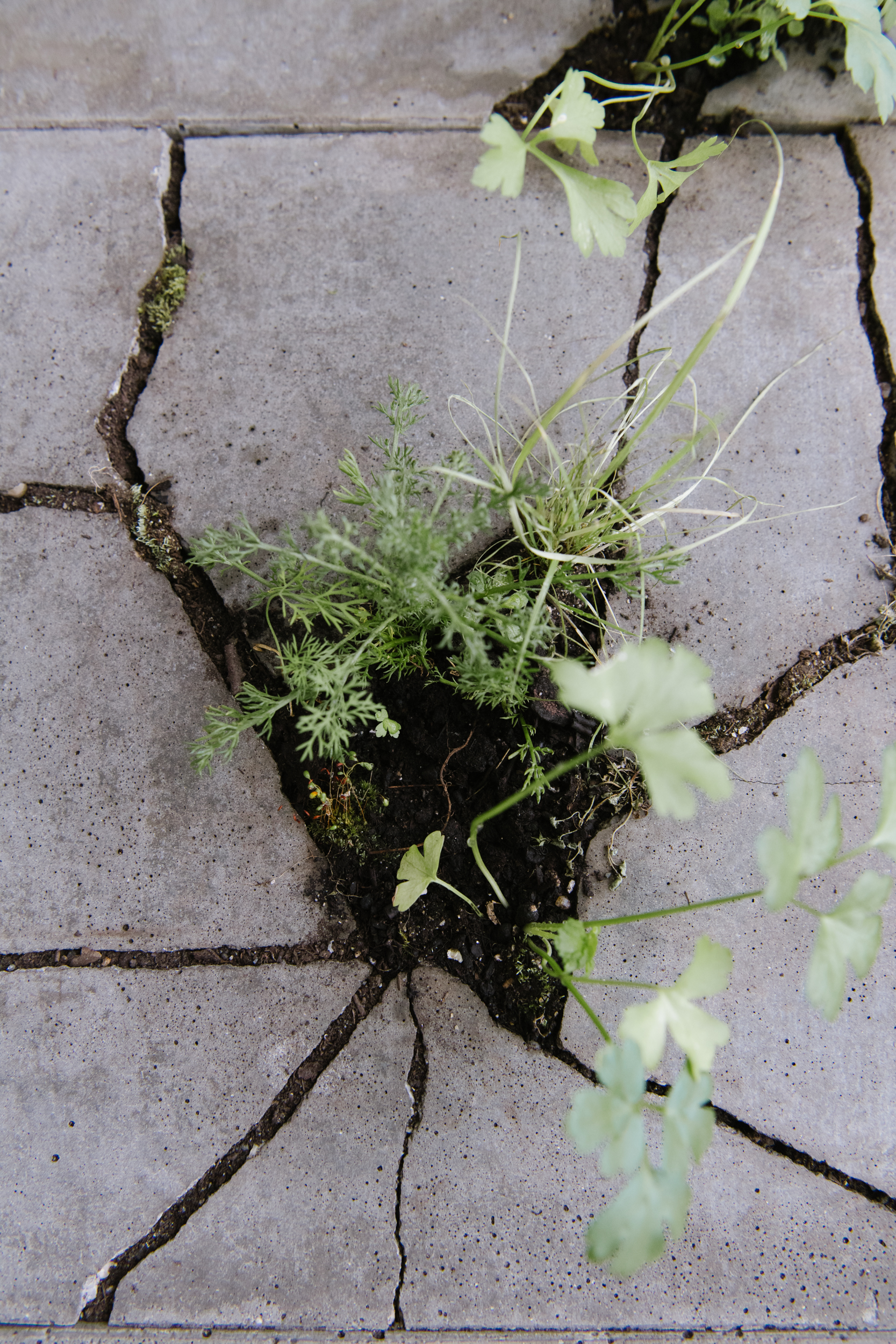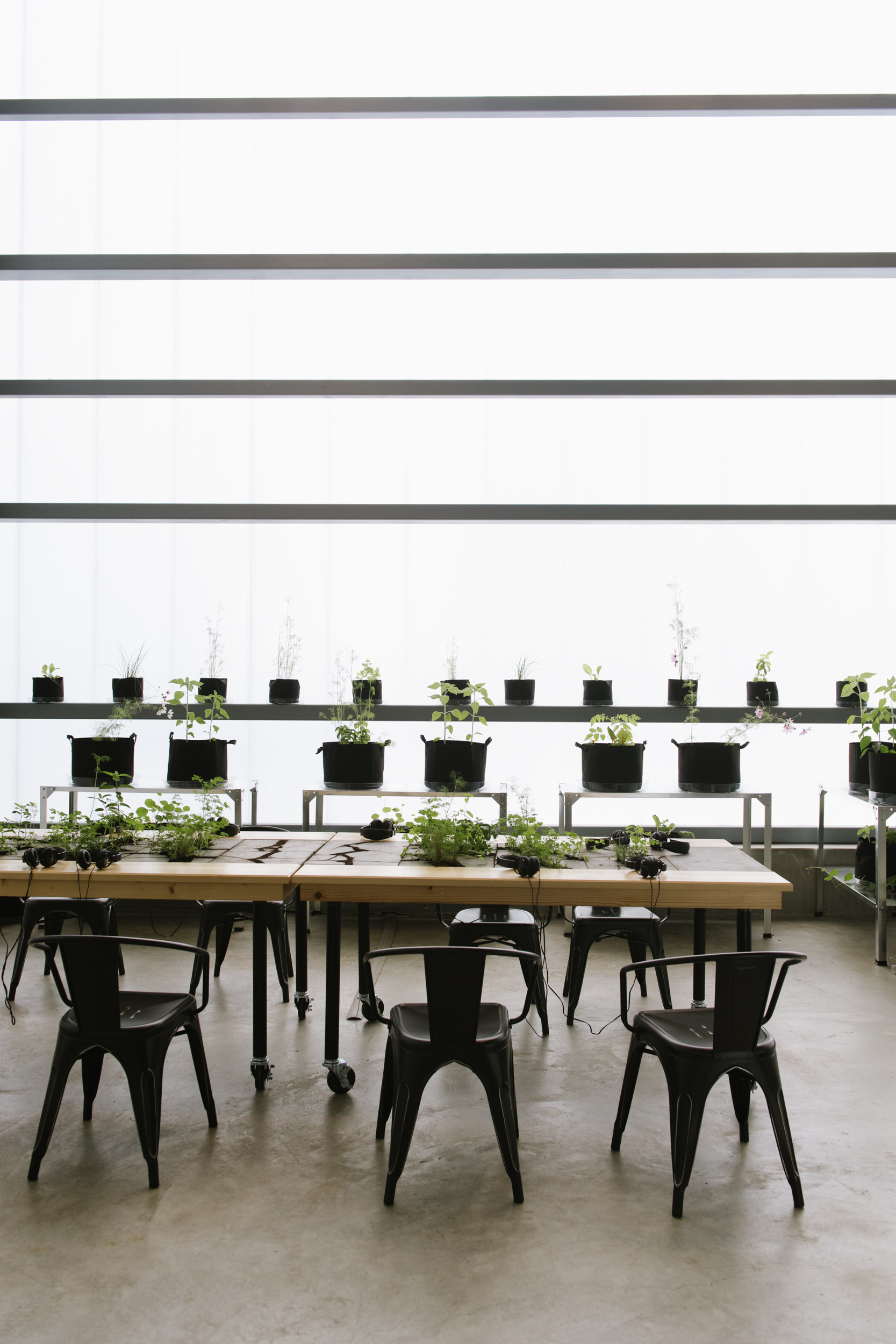The Little Farm That Could
Photos by Katie Noble
On a Residential Lot in a Rapidly Changing Neighborhood, a Tiny Farm’s Significance Goes Far Beyond Growing Food
This is the story of a farm, but probably not the kind you’ve ever thought of. This farm, probably more accurately called a community garden, is nestled on 3,100 square feet smack in the middle of a long block of triple-deckers in Jeffries Point, a rapidly gentrifying section of East Boston. It’s a splotch of nature in a sea of concrete and brick, an oasis of community and sharing in a neighborhood real estate developers are mining like 19th-century gold prospectors.
For years a derelict and abandoned lot, Eastie Farm obtained ownership of the space late this spring from the City of Boston for $100 (more on that later). There’s still a fence between the sidewalk and the farm, but the swinging gate is frequently unlocked. That’s because Eastie Farm belongs to all of us—and I say “us” because I live two blocks from the space and have watched it grow—and anyone is free to plant and harvest what they want; to drop by for 20 minutes of serenity amid a busy day; or to pitch in an hour of labor at the weekly Saturday “work parties.” A sign on the fence welcomes all into the farm: Bienvenidos.
For many in the community, the welcome and diversity that they find here, around a tiny patch of dirt on Sumner Street, stands in stark contrast to the exclusive luxury housing developments popping up throughout Eastie.
“Jeffries Point has been growing rapidly, housing density increasing at an overwhelming rate,” says Riko Cribbs, who lived a street over from the farm until a rent hike forced her to leave the neighborhood. “It feels like there are buildings on top of buildings. Eastie Farm provides some space to breathe in East Boston.”
Perhaps no neighborhood in Massachusetts has experienced more change in the last decade than East Boston. Ten years ago, one could easily find a two-bedroom apartment here for less than $1,000, and families were snatching up single-family homes with yards for $300,000 or less. Residents here felt like their neighborhood was a well-kept secret, and they strove to keep it that way.
Eastie’s story is the immigrants’ story. For more than 150 years, wave after wave of newcomers have arrived here from around the globe: Russian Jews in the mid-1800s, then the Irish, then the Italians. At one point, a century or so ago, only Ellis Island processed more immigrants than East Boston.
Today, while vestiges of Eastie’s Italian heritage remain, a plurality of storefront signs here are in Spanish; the neighborhood is home to perhaps the largest concentration of Central American immigrants in New England. In addition to Latinos, Moroccans and Egyptians are two other fast-growing immigrant groups in Eastie.
The current real estate boom—bigger and more sustained than any of the boomlets that have come periodically throughout East Boston’s history—is driving up living costs and displacing many low- to middle-income families. That includes immigrants and people of color, yes, but also many elderly and long-time residents who happen to rent their homes. Some fear this trend could result in the diversity for which East Boston has always been known diminishing—or disappearing altogether.
It was into Eastie’s development boom—and, perhaps, because of it—that Eastie Farm was born. Margaret Farmer, a board member at the Jeffries Point Neighborhood Association (JPNA), which oversaw the initial approval of Eastie Farm, recalls that the farm prevailed during an optimal window when residents were tired of the cranes, traffic and rising rents.
“Even two to three years earlier,” she says, “we wouldn’t have gotten it.”
From a real estate standpoint, 294 Sumner St. is much more valuable as a built structure than farmland, perhaps collecting upwards of $600 per square foot—the median price-per-square-foot in East Boston in April 2019, according to zillow.com. Behind Boston Mayor Marty Walsh’s early promise to approve the construction of 50,000 new units of housing by 2030 to accommodate the city’s ballooning population, the city has been on an absolute building tear. It sometimes feels like any space that can be developed, will.
Which makes the city’s transfer of a buildable lot in perhaps its fastest-growing neighborhood to a tiny agricultural nonprofit to grow food so improbable. That outcome, which took four years to come to fruition and was finalized, with conditions, in April, was never a guarantee—far from it—and along the way, many neighbors of good will were skeptical whether a farm was the best and highest use for the lot.
At this point, I need to come clean about something: When the idea first surfaced, I was an Eastie Farm skeptic.
Historically, I’ve pretty reliably fallen into the “grow food everywhere” camp. But when a local restaurateur, Monica Leitner-Laserna, approached the JPNA in June 2015 with an idea to turn 294 Sumner St. into a community farm, I saw it as a short-term use rather than a long-term solution. Put the abandoned lot to good use now, I thought, but eventually someone will build on it. After all, it’s the one empty lot on the block—a “missing tooth,” as some called it—and a home or storefront would knit the row together. It would restore continuity.
Nevertheless, in August 2015 the city issued Leitner-Laserna a temporary permit to use 294 Sumner St. to grow food. As the permit neared its completion, though, the city tossed the matter back to the Jeffries Point Neighborhood Association to determine how residents wanted the space to be used long-term. In October of that year, Eastie Farm beat out proposals for a mixed-use building and a high-end condominium, respectively—a direct rebuke of the deluge of construction occurring at the time, according to Farmer.
“People suddenly had this realization that open space in East Boston was something to protect,” she says, “and Eastie Farm gave them something to get behind.”
My tune on Eastie Farm began to change in the summer of 2016, the farm’s first full growing season, as I noticed that it was as much a gathering place as it was a growing place. Smiling neighbors converged on the former abandoned lot throughout the week to tend to a cornucopia of produce and flowers: sweet cherry tomatoes, spicy peppers, deep green kale and savory sage, to name a few. Some brought food they cooked at home—often from the cook’s home country of Somalia, Colombia or India—to nibble on between weeding sessions, and gardeners sipped on warm chai. One could drop in during the middle of the week to tend to a crop they were growing or simply to escape from the busyness of the city. I watched events held in the space become a magnet for people of every age, race, cognitive ability, income and experience growing food. My own kids came alive when we visited Eastie Farm and always left with dirty fingers and knees.
Despite a lack of formal rules, I witnessed the Eastie Farm community police itself, taking care not to plant over someone else’s seeds and respecting an honor system for what they took out of the garden. Executive Director Kannan Thiruvengadam says that in four years, just two items—a watering can and a potted plant—were taken from the space without permission.
In case of any disputes (of which, I’m told, there have been few), Thiruvengadam and his partner, Rudi Seitz, were in the space almost every day, loosely planning what’s growing where, who’s using the space and planning events. Thiruvengadam, now Eastie Farm’s executive director, says the focus from the beginning was “showing that this is a very active and happy space.”
Finally, after almost four years, the City of Boston turned ownership of the tiny lot over to Eastie Farm in April of this year for a period of 30 years, along with a $100,000 grant to put toward growing food there. In return, Eastie Farm paid the city $100 and agreed not to rent or sell the property, grow or store marijuana or put up any structures that fall outside the zoning code. The city even agreed to donate a water hookup to the space, which could have cost Eastie Farm up to $60,000 to do itself. City Councilor Lydia Edwards, who has become known for her work to stem the tide of gentrification in Eastie, recognizes Eastie Farm’s permanency as a win for community and diversity.
“What we see [at Eastie Farm] is a genuine gathering of a cross section of East Boston excited about growing, getting in the dirt and getting to know one another,” Edwards says. “I am so proud of the work, and to see it continue to grow is a testament to our beautiful diverse community.”
This summer is Eastie Farm’s fourth full growing season, and its contributions to the neighborhood are being recognized in higher and higher places. The City of Boston has tapped the group to manage a garden on a city-owned parcel on Border Street in Eastie, and Thiruvengadam says the farm could soon take over two additional empty parcels in the neighborhood.
One of Boston’s preeminent cultural institutions is also collaborating with Eastie Farm this summer. At the Institute of Contemporary Art’s Watershed in East Boston—reachable by water taxi from the museum—artist Evelyn Rydz is partnering with Thiruvengadam and Eastie Farm to present “Aquí y allá: juntos a la mesa” (Here and there: Together at the table), an exhibition featuring stories of food and community, ecological walking tours of the farm and neighborhood, and a stunning visual centerpiece of herbs bursting up through cracks in the concrete. Thiruvengadam calls the exhibit “a visual statement of the resilience of plant communities in the face of industrial domination”—an apt description, as it were, of Eastie Farm itself. Four years ago, Eastie Farm was fighting for its life in community meetings; today, the group is respected at the highest levels of government and culture.
“[That] means Eastie Farm is an agent of change,” Thiruvengadam says. “Society often resists change, but the right kind of change is not only acceptable, but eventually celebrated.”
Accolades come and go, but Eastie Farm’s lifeblood is at 294 Sumner. There, groups of children are gathering this summer to partake in the miracle of growing food and learn how climate change is affecting East Boston—a topic near to Thiruvengadam’s heart. Ken Grifoni, who’s lived in the house immediately to the farm’s left for the past 60 years, walks his 4-year-old grandson, Anthony, into the space most Saturdays to pick basil to put in his Sunday gravy. Immigrants choose a hoop house and cultivate crops from their home country, like Salvadoran corn or Brazilian eggplant. Volunteers carry boxes of food they’ve harvested a few blocks to the East Boston Community Soup Kitchen to be enjoyed by neighbors who are unhoused and living in poverty. And Jeanne Schaduto Belmonte strolls past the farm and remembers with fondness growing up at 294 Sumner, when it was a triple-decker with a small garden and a grapevine in the backyard.
“I think my father would have really liked it,” Belmonte says of what her childhood home has become. “If my father were alive, he probably would have been down there sitting on the bench and telling his stories—they were all storytellers. Same with my uncle, Johnny: telling his stories about how they had a turkey in the yard and my father’s pigeon and chicken coop. I’m really glad it’s going to be green space.”
Me, too.
This story appeared in the Summer 2019 issue.









